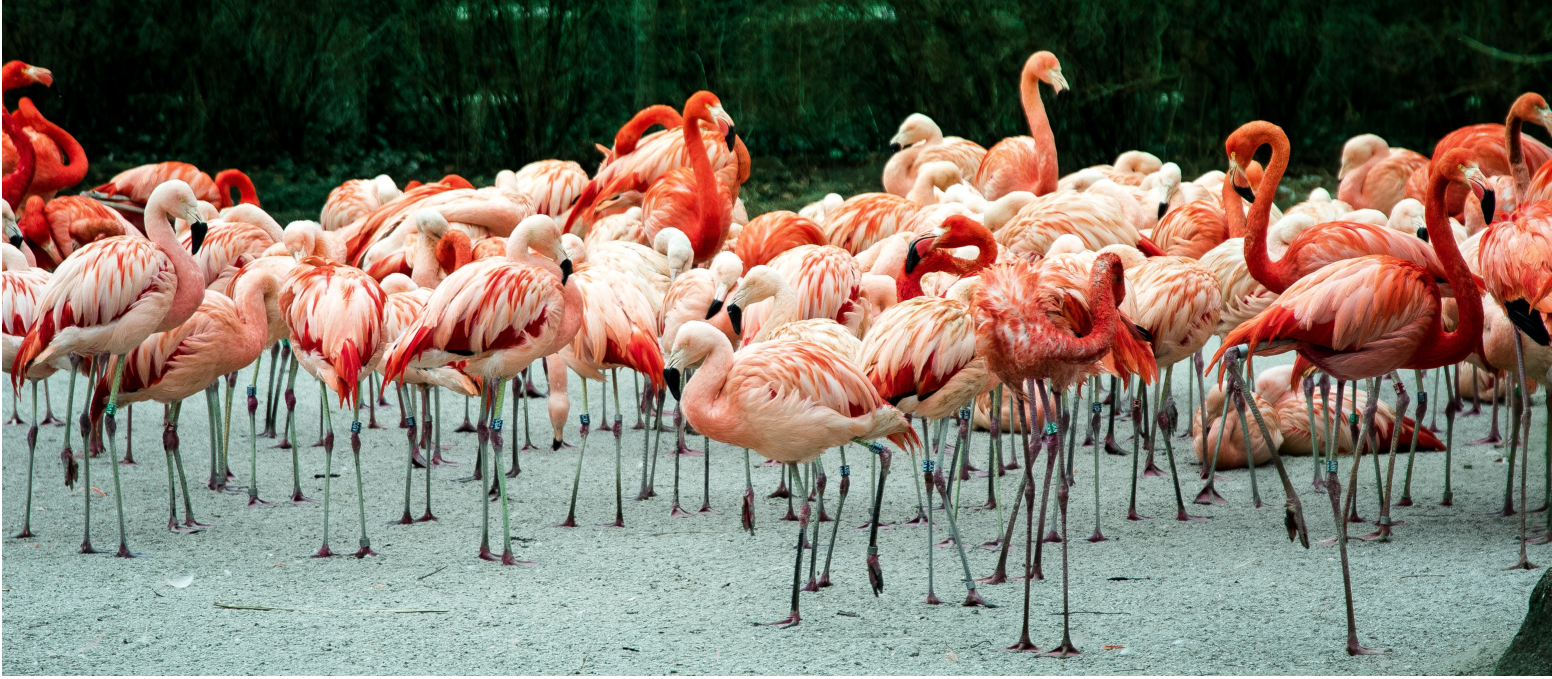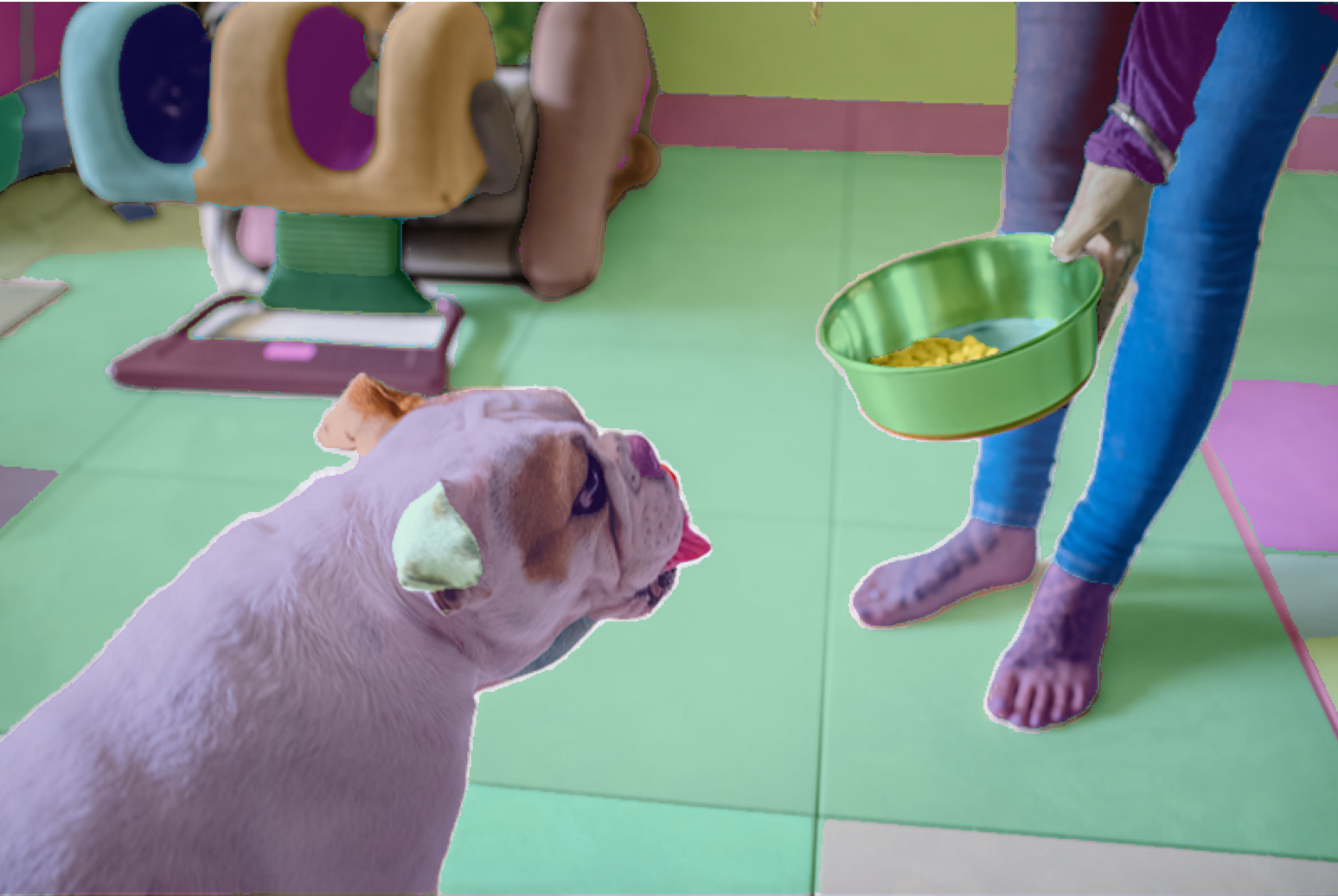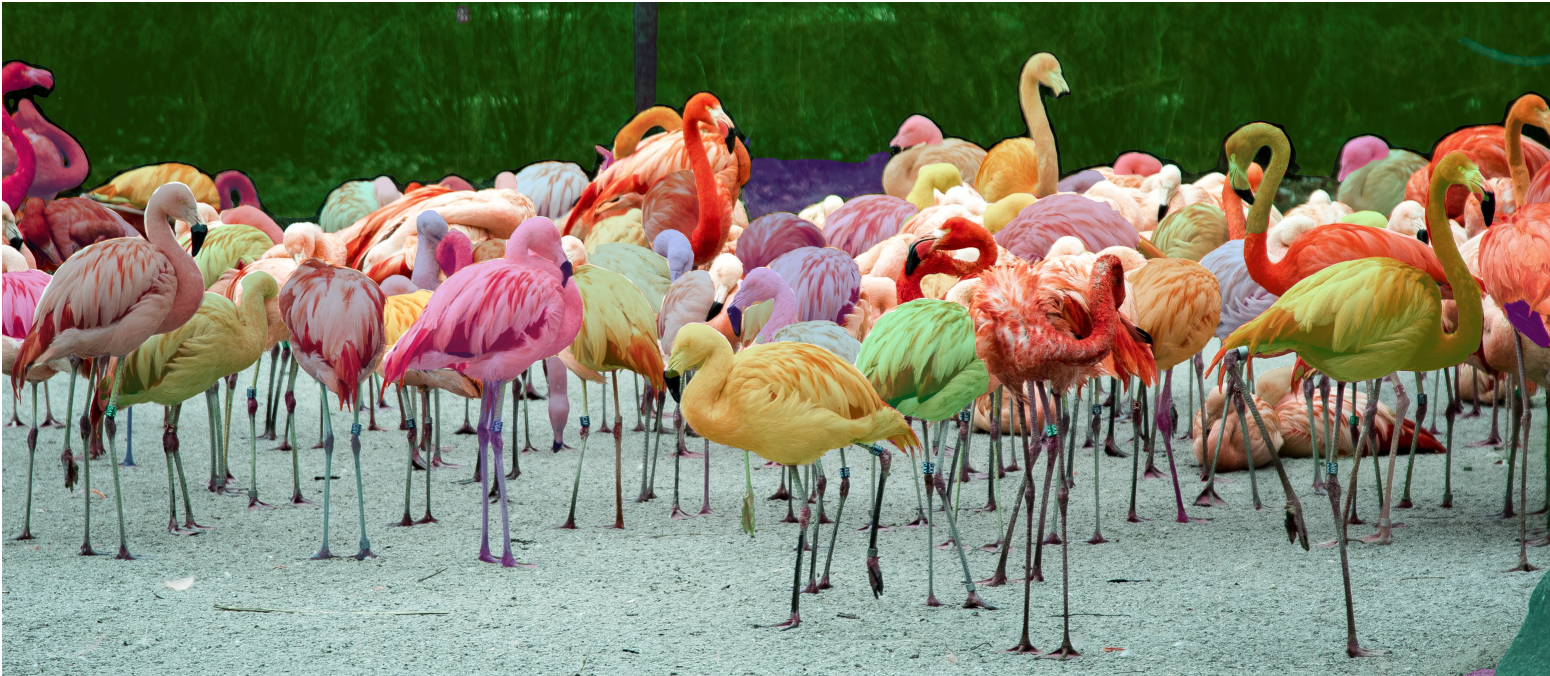元画像と,生成されたセグメンテーションマスク




Segment Anything(SA)は、画像セグメンテーションのための基盤モデルを構築することを目的としたプロジェクトである。このプロジェクトでは、新しいデータ分布とタスクに一般化できるプロンプト可能なセグメンテーションモデルSegment Anything Model(SAM)が開発された。Segment Anything Model(SAM)はゼロショットでのセグメンテーションが可能である。さらに、1100万枚以上の画像と、それらの画像に対する10億以上のマスクを含むセグメンテーションデータセットSA-1Bデータセットが構築された。
【文献】
Alexander Kirillov, Eric Mintun, Nikhila Ravi, Hanzi Mao, Chloe Rolland, Laura Gustafson, Tete Xiao, Spencer Whitehead, Alex Berg, Wan-Yen Lo, Piotr Dollar, Ross Girshick, Segment Anything, arXiv:2304.02643, 2023.
https://arxiv.org/pdf/2304.02643v1.pdf
【関連する外部ページ】
Gitは,バージョン管理システム.ソースコードの管理や複数人での共同に役立つ.
【サイト内の関連ページ】
Windows での Git のインストール: 別ページ »で説明している.
【関連する外部ページ】
Git の公式ページ: https://git-scm.com/
【サイト内の関連ページ】
【関連する外部ページ】
Python の公式ページ: https://www.python.org/
【サイト内の関連ページ】
NVIDIA グラフィックスボードを搭載しているパソコンの場合には, NVIDIA ドライバ, NVIDIA CUDA ツールキット, NVIDIA cuDNN のインストールを行う.
【関連する外部ページ】
コマンドプロンプトを管理者として実行: 別ページ »で説明
PyTorch のページ: https://pytorch.org/index.html
次のコマンドは, PyTorch 2.0 (NVIDIA CUDA 11.8 用) をインストールする. 但し,Anaconda3を使いたい場合には別手順になる.
事前に NVIDIA CUDA のバージョンを確認しておくこと(ここでは,NVIDIA CUDA ツールキット 11.8 が前もってインストール済みであるとする).
PyTorch で,GPU が動作している場合には,「torch.cuda.is_available()」により,True が表示される.
python -m pip install -U --ignore-installed pip python -m pip install -U torch torchvision torchaudio numpy --index-url https://download.pytorch.org/whl/cu118 python -c "import torch; print(torch.__version__, torch.cuda.is_available())"
![[image]](../../tools/man/529.png)
Anaconda3を使いたい場合には, Anaconda プロンプト (Anaconda Prompt) を管理者として実行し, 次のコマンドを実行する. (PyTorch と NVIDIA CUDA との連携がうまくいかない可能性があるため,Anaconda3を使わないことも検討して欲しい).
conda install -y pytorch torchvision torchaudio pytorch-cuda=11.8 cudnn -c pytorch -c nvidia py -c "import torch; print(torch.__version__, torch.cuda.is_available())"
【サイト内の関連ページ】
【関連する外部ページ】
公式の GitHub ページ: https://github.com/facebookresearch/segment-anything の記載に従う.
コマンドプロンプトを管理者として実行: 別ページ »で説明
cd %HOMEPATH% rmdir /s /q segment-anything git clone --recursive https://github.com/facebookresearch/segment-anything cd segment-anything python -m pip install -e . python -m pip install -U opencv-python pycocotools matplotlib onnxruntime onnx gdown mkdir pretrained_checkpoint
エラーメッセージが出ていないこと.
![[image]](../../ai/win/605.png)
![[image]](../../ai/win/606.png)
次のコマンドを実行することにより, 公式ページで公開されている学習済みモデル vit_b: ViT-B SAM model, vit_l: ViT-L SAM model, vit_h: ViT-H SAM model をダウンロードする.
cd %HOMEPATH%\segment-anything cd pretrained_checkpoint curl -L -O https://dl.fbaipublicfiles.com/segment_anything/sam_vit_b_01ec64.pth curl -L -O https://dl.fbaipublicfiles.com/segment_anything/sam_vit_l_0b3195.pth curl -L -O https://dl.fbaipublicfiles.com/segment_anything/sam_vit_h_4b8939.pth
![[image]](../../ai/win/608.png)
cd %HOMEPATH%\segment-anything python -m pip install -U timm python scripts/amg.py --checkpoint ./pretrained_checkpoint/sam_vit_l_0b3195.pth --model-type vit_l --input ./notebooks/images --output ./results
![[image]](../../ai/win/609.png)
元画像の画像ファイルは,notebooks\images にある
![[image]](../../ai/win/610.png)
結果の画像ファイルは,results にある
![[image]](../../ai/win/611.png)
![[image]](../../ai/win/612.png)
![[image]](../../ai/win/614.png)
実行時にファイルを選択する.ファイルは複数選択可能である.
cd %HOMEPATH%\segment-anything notepad segment.py
![[image]](../../ai/win/615.png)
このプログラムは,公式の Sement Anything のページで公開されていたものを参考に作成.
from segment_anything import SamAutomaticMaskGenerator, sam_model_registry
import numpy as np
import torch
import matplotlib.pyplot as plt
import cv2
import tkinter as tk
from tkinter import filedialog
def main():
sam_checkpoint = "./pretrained_checkpoint/sam_vit_h_4b8939.pth"
model_type = "vit_h" # "vit_l/vit_b/vit_h"
device = "cuda"
sam = sam_model_registry[model_type](checkpoint=sam_checkpoint)
sam.to(device=device)
mask_generator = SamAutomaticMaskGenerator(sam)
root = tk.Tk()
root.withdraw()
fpaths = filedialog.askopenfilenames()
def show_anns(anns):
if len(anns) == 0:
return
sorted_anns = sorted(anns, key=(lambda x: x['area']), reverse=True)
ax = plt.gca()
ax.set_autoscale_on(False)
img = np.ones((sorted_anns[0]['segmentation'].shape[0], sorted_anns[0]['segmentation'].shape[1], 4))
img[:, :, 3] = 0
for ann in sorted_anns:
m = ann['segmentation']
color_mask = np.concatenate([np.random.random(3), [0.35]])
img[m] = color_mask
ax.imshow(img)
i = 0
for fpath in root.tk.splitlist(fpaths):
print("file name: ", fpath)
bgr = cv2.imread(fpath)
rgb = cv2.cvtColor(bgr, cv2.COLOR_BGR2RGB)
plt.figure(figsize=(20, 20))
plt.imshow(rgb)
plt.axis('off')
plt.show()
masks = mask_generator.generate(rgb)
plt.figure(figsize=(20, 20))
plt.imshow(rgb)
show_anns(masks)
plt.axis('off')
plt.savefig(str(i) + ".png", bbox_inches='tight', pad_inches=0, transparent=True)
print(str(i) + ".png" + " saved.")
plt.show()
plt.close() # グラフを閉じる
i = i + 1
if __name__ == "__main__":
main()
![[image]](../../ai/win/616.png)
Python プログラムの実行
Python 開発環境(Jupyter Qt Console, Jupyter ノートブック (Jupyter Notebook), Jupyter Lab, Nteract, Spyder, PyCharm, PyScripterなど)も便利である.
Python のまとめ: 別ページ »にまとめ
プログラムを segment.pyのようなファイル名で保存したので, 「python segment.py」のようなコマンドで行う.
python segment.py
![[image]](../../ai/win/617.png)
![[image]](../../ai/win/618.png)
確認したら,右上の「x」をクリックする.右上の「x」をクリックするまでは,プログラム実行は中断している.
![[image]](../../ai/win/619.png)
確認したら,右上の「x」をクリックする.右上の「x」をクリックするまでは,プログラム実行は中断している.
![[image]](../../ai/win/620.png)
ファイル名は,0.png, 1.png, 2.png, ... のようになっている.
![[image]](../../ai/win/621.png)
パソコンのビデオカメラで実行する.
cd %HOMEPATH%\segment-anything notepad vidcam.py
![[image]](../../ai/win/626.png)
このプログラムは,公式の Sement Anything のページで公開されていたものを参考に作成.
学習済みモデルは最も軽量なものを選んでいる.
from segment_anything import SamAutomaticMaskGenerator, sam_model_registry
import numpy as np
import torch
import matplotlib.pyplot as plt
import cv2
def main():
sam_checkpoint = "./pretrained_checkpoint/sam_vit_b_01ec64.pth"
model_type = "vit_b" # "vit_l/vit_b/vit_h"
device = "cuda"
sam = sam_model_registry[model_type](checkpoint=sam_checkpoint)
sam.to(device=device)
mask_generator = SamAutomaticMaskGenerator(sam)
def get_anns(anns):
if len(anns) == 0:
return
sorted_anns = sorted(anns, key=(lambda x: x['area']), reverse=True)
ax = plt.gca()
ax.set_autoscale_on(False)
img = np.ones((sorted_anns[0]['segmentation'].shape[0], sorted_anns[0]['segmentation'].shape[1], 4))
img[:, :, 3] = 0
for ann in sorted_anns:
m = ann['segmentation']
color_mask = np.concatenate([np.random.random(3), [0.35]])
img[m] = color_mask
return img
print("Prease press q to exit")
cap = cv2.VideoCapture(0)
while (cap.isOpened()):
r, f = cap.read()
if (r == False):
print("Video Capture Error")
break
else:
cv2.imshow('Video Capture', f)
if cv2.waitKey(1) & 0xFF == ord('q'):
break
masks = mask_generator.generate(f)
img = get_anns(masks)
cv2.imshow('SAM Result', img)
if cv2.waitKey(1) & 0xFF == ord('q'):
break
cap.release()
cv2.destroyAllWindows()
if __name__ == "__main__":
main()
![[image]](../../ai/win/627.png)
Python プログラムの実行
Python 開発環境(Jupyter Qt Console, Jupyter ノートブック (Jupyter Notebook), Jupyter Lab, Nteract, Spyder, PyCharm, PyScripterなど)も便利である.
Python のまとめ: 別ページ »にまとめ
プログラムを vidcam.pyのようなファイル名で保存したので, 「python vidcam.py」のようなコマンドで行う.
python vidcam.py
![[image]](../../ai/win/628.png)
q キーで終了する.
![[image]](../../ai/win/629.png)
![[image]](../../ai/win/630.png)